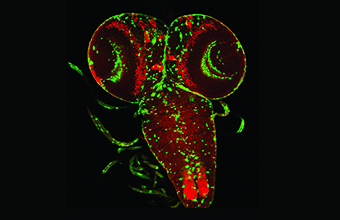College of Arts and Sciences Newsroom

'Cancer Research' Cover
A University of Dayton professor's research into ways to identify and possibly treat an aggressive form of brain cancer was part of a study published in the prestigious journal Cancer Research. That issue's cover image - a microscopic view of a fruit fly's central nervous system - was taken in Madhuri Kango-Singh's laboratory and highlights her work on the study.
Kango-Singh, associate professor of genetics in the department of biology, is a co-author of the multi-institution study, along with her former graduate student, Indrayani Waghmare, who received her doctorate from the University in 2016.
The research collaboration started in 2012 and is led by Dr. Ichiro Nakano, a neurosurgery professor and academic neurosurgeon at the University of Alabama at Birmingham. It is funded through grants from the National Cancer Institute and National Institutes of Health, and also includes the University of Pisa, Italy; the James Comprehensive Cancer Center at the Ohio State University; the Lerner Research Institute at Cleveland Clinic; Cincinnati Children’s Hospital Medical Center; and the University of Texas MD Anderson Cancer Center in Houston.
In the Cancer Research study, researchers identify a biomarker enzyme associated with aggressive glioma brain tumors; reveal the regulatory mechanism for that enzyme; and demonstrate potent effectiveness, using a mouse model for glioma, of a small molecule inhibitor they have developed.
Kango-Singh’s team used fruit flies as a model organism to identify genes that might play a role in human brain cancers, and to help them understand how signaling interactions between cancer cells and other neighboring cells lead to uncontrolled cancer growth. They discovered that cancer cells hijack normal signaling pathways to cause this type of abnormal growth. They also found the interactions amongst these pathways are unique and not found in normal cells.
“Understanding how cancer cells have growth advantage in response to genetic aberrations has been one of the challenges for cancer biologists,” said Waghmare, now a post-doctorate researcher at Vanderbilt University in Nashville, Tennessee. “We know there are several mutations that are associated with cancer but we have very little understanding how these mutations lead to cancer. I think my work has contributed to addressing a part of this question.”
Partner research groups simultaneously studied these genetic connections in other cancer models, including mice and human patient samples. Together, they learned there were similarities between what Kango-Singh and Waghmare found with fruit flies and what other groups were seeing in more advanced systems.
“That was the basis for finding these evolutionary conservative relationships — meaning that whatever we find in flies is also true for how the relationship between these genes works in human systems,” Kango-Singh said. “That was my part.”
By putting their studies together, the research groups could then show certain genes that are present in multiple systems from an evolutionary perspective could be useful biomarkers, whose presence indicates glioma brain tumors.
“So, if we study these genes, maybe we could find better ways of stopping or inhibiting their function,” Kango-Singh said.
The research groups communicated every few weeks to share their findings and determine how to make the various systems more complimentary. They also determined which genes to target to help develop compounds for therapy.
Kango-Singh said the group is now looking to bring their inhibitor to clinical trials. In addition, the researchers are working on another paper about their findings.
“Our work is ongoing,” she said. “My strength is doing fruit fly research and working with fruit fly cancer models, so our continued collaboration is to find other genes and molecular signals — things that connect to each other by communicating through enzymes. My job is to characterize these other genes in fruit flies and then show that they have a fundamental function in the brain.”
Genetically manipulating fruit flies allows cancer researchers to follow the development and progression of tumors from their earliest stages, because the changes that initiate the process can be observed during the flies’ natural development.
In contrast, cancer cell lines derived from patient tissue have already experienced a number of changes and mutations, and continue to accumulate more changes — resulting in a more complex system — as time goes on.
“Using fruit flies, you can really look for the minimum number of combinations that will start out the process, and then study all the different changes that happen,” Kango-Singh said. “You can get some good insights from the fly model.”
Kango-Singh joined the University of Dayton faculty in 2009 and teaches both undergraduate- and graduate-level genetics courses. She has worked in the area of tumor growth regulation for two decades. Previously, she was an assistant professor at the Mercer University School of Medicine and a post-doctorate researcher at the MD Anderson Cancer Center.
Waghmare holds a bachelor’s degree from Hislop College in Nagpur, India, and a master’s in molecular biology from Umeå University in Sweden.
- Dave Larsen, communication coordinator, College of Arts and Sciences
